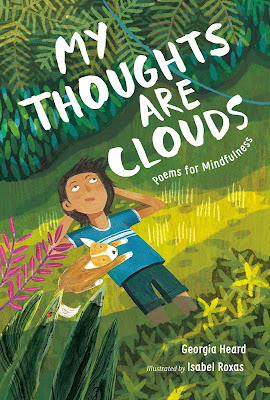on the wing
Bibliography: Florian, Douglas. on the wing. New York, Voyager Books, 2000. ISBN: 978-0152023669.
Summary:
In this collection of bird poems and paintings by Douglas Florian, 21 species of birds receive whimsical poetic tributes paired with equally playful paintings. On the wing features the egret, the green catbird, the vulture, quetzal, and whooping crane to name a few. Readers will recognize some familiar feathers while others will be strange new friends rendered in words and watercolors. Florian captures both the unique appearance and behaviors of the birds in his short, rhyming poems.
Analysis:
In Douglas Florian’s on the wing, he celebrates various birds with clever rhymes and quirky, surrealistic art. His similes, such as the Andean cock-of-the-rock’s “crest that’s as round as a clock,” are depicted literally in his paintings, the bird’s red crest marked with numbers and clock hands. Inside the head of the hill mynah, whose voice “can mimic anything,” appears a reel-to-reel tape player. “I echo every word that’s said. / (A tape recorder’s in my head.)” These fun connections between word and art will delight readers who can spot the matching details. The birds are frequently personified, placed in human settings, or festooned with medals such as the magnificent frigate bird. “The whooping crane, / the whooping crane, / So big it’s practically a plane” is painted with jet engines tucked under its wings, landing gear fixed where feet would be, and a cockpit nestled it the dome of its head. Tiny human faces peer out of a row of airplane windows embedded in its back.
Rhyme and meter give each poem a musical quality making them perfect for memorization, singing, or choral reading. “On morning tide / an egret sat / and gave the beach / a feathered hat.” The book is filled with short poems like this one, with pleasing rhymes and surprising endings. Florian also employs alliteration and internal rhyme to great effect: “The wondrous white-tailed kite-- / A never boring soaring sight / As it glides on gull-like wings, / A kite that flies but has no strings.” (Naturally, the poem’s painting shows the bird hovering among a flock of actual kites.)
Florian also uses text styles to add movement and whimsy to his creations. The quetzal’s long tail, which appears on the book’s cover, is painted as a connect-the-dots drawing. Similarly, the text of the concrete poem spirals like the bird’s green tail, inviting the reader to trace the words to its punchline. The roadrunner poem uses leaning italics: “Past tumbleweeds / It speeds for snakes, / And catching them, / Turns on the breaks.” In the poem, the words speeds leans forward, but the word brakes, leans backwards as if screeching to a stop. In the poem “The Magnificent Frigate Birds,” the text of the words soar, glide, wheel, and inflate mimic their meanings, stretching out or lifting up, slightly larger or smaller than the surrounding text. Readers will laugh with delight at Douglas Florian’s imaginative sense of humor and visual metaphors. A fun and musical read for elementary-aged readers.
Excerpt:
“The Dippers”
Through splash and spray
Of waterfalls
Skip the little dippers.
I think that they
Would gladly trade
Their oily wings for flippers.
Inside a stream
They swim supreme,
For minutes if they wish--
These funny little songbirds
Who think that they are fish.
Activity:
Introduce the poem by telling students that we are going to read about a bird called a “dipper.” Ask students: Where do you think it gets its name?
Read the poem aloud and ask students to imagine what these birds look like.
Show students this short National Geographic video of the American dipper in action. https://youtu.be/6ERPmoYsoMg
Read the poem again, and invite students to pretend they are dippers splashing and zooming through the water.




Comments
Post a Comment